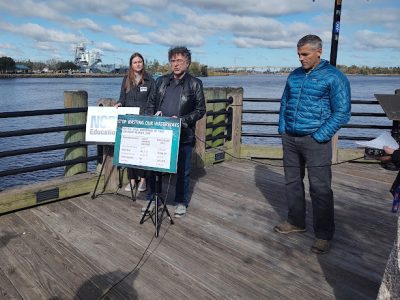
Updated Oct. 6 to include comments from the EPA
DOWNTOWN WILMINGTON — North Carolina is home to two of the top five watersheds in the country that had the highest amounts of toxins discharged in 2020 – the upper New River and the lower Cape Fear River, a new report finds.
Supporter Spotlight
With the Cape Fear River as a backdrop in downtown Wilmington, advocates released the findings of the study, “Wasting Our Waterways: Toxic pollution and the unfulfilled promise of the Clean Water Act,” published Sept. 28, to a handful of journalists Tuesday morning on the riverwalk.
“We’re here today along the banks of the Cape Fear River because North Carolinians deserve clean water. Our waterways should be safe for swimming, fishing and drinking, and our children deserve a toxic free future,” North Carolina Public Interest Research Group Education Fund State Director Katie Craig told reporters.
“Yet today, 50 years after the passage of the Clean Water Act, we continue to allow companies to use chemicals linked to a wide range of health threats, including cancer, developmental damage, reproductive damage and more.”
NCPIRG is a state-based, citizen-funded advocacy group that is an advocate for the public interest. Environment America Research & Policy Center and U.S. PIRG Education Fund produced the report based on data from the Environmental Protection Agency’s Toxics Release Inventory, or TRI.
There were 10,266,141 pounds of toxins released in the upper New River watershed located in North Carolina, Tennessee and Virginia and 5,017,810 pounds in the lower Cape Fear that year, according to the report.
Supporter Spotlight
Industrial facilities released at least 193.6 million pounds of toxic substances into U.S. waterways in 2020, including many known to cause cancer, reproductive problems and developmental issues. Of the top ten 10 states by total releases of toxic substances, North Carolina came in at No. 6 with 9,746,239 pounds behind Texas, Indiana, Virginia, Louisiana and Alabama.
The report finds North Carolina to have the highest levels in the country of dumped toxins linked to developmental delays, Craig said. These toxins cause developmental effects that interfere with the processes of growth and change in the body from conception through adolescence.
“In 2020, over 4.5 million pounds of developmental toxins were released by industrial and government facilities into our waterways across the country,” she said, adding that facilities in the state released the most developmental toxins of any state at over 600,000 pounds.
“With facilities dumping so much pollution, no one should be surprised that so many of our rivers, lakes and streams are still unsafe for swimming and fishing and other recreational activities. But we should be outraged, North Carolinians’ waterways should not be a dumping ground for our polluters.”
She explained that the full scope of toxic pollution flowing into waterways was even greater than that reported to the inventory, which is data collected from the polluting facilities to the Environmental Protection Agency.

“For example, the TRI data does not include releases of thousands of toxic PFAS chemicals, of which only a very small segment were reported for the first time to this report in 2020, and likely under reported at that, ” she said, adding toxic chemicals industrial facilities send to sewage treatments, toxins from stormwater and agricultural runoff are also not included.
“That’s why we’re calling on federal agencies like the EPA, as well as federal and state governments, and even manufacturers and retailers themselves to take action to drastically reduce the use of these toxic chemicals,” Craig said.
Craig said the restriction on the use of PFAS and other toxic chemicals needs to be dramatic, especially when safer alternatives already exist. The state and federal agencies need to update their abilities to hold polluters accountable and stop toxic chemicals from being permitted to end up in our waterways in the first place, she said.
Cape Fear Riverkeeper Kemp Burdette with Cape Fear River Watch said the local grassroots environmental nonprofit focuses on the water quality of the Cape Fear River.
“This report is especially important, and especially troubling,” Burdette said. “We drink this river, and we eat the fish out of this river and the shellfish out of this river. And we swim in the water from this river.”
The area has been drinking PFAS-contaminated water for 40 years, he said.
“The technology exists to remove PFAS pollution. We can remove almost every nanogram of PFAS pollution created by polluters and we have to start doing that now. We can’t wait for more and more of these chemicals to be regulated,” Burdette said. “Even more important than removing the PFAS pollution that we create every day is stopping the production of what we know is an incredibly toxic class of chemicals.”
The report also highlights that nitrate pollution makes up about 90% of pollution in the country’s waterways.
“Nitrate pollution is important because it causes fish kills, algal blooms, sometimes toxic algal blooms and can even cause entire dead zones and waterways and estuaries and coastal areas,” Burdette said.
He also expressed worry that, while the report covers an enormous amount of self-reported data from the Toxic Release Inventory, it’s clear there’s even more contamination in waterways across the US, and especially in the Cape Fear basin.
“We’re the center of production in this country for poultry right now. North Carolina produces more poultry than any other state in the country, and the Cape Fear basin is the most densely concentrated area for swine production in the entire world,” Burdette said. “So while this report highlights reported pollution, there is an enormous amount of pollution that is unreported that combines with this reported pollution to impact water quality here in the Cape Fear River.”
Burdette noted that the Clean Water Act turns 50 years old this year, a significant accomplishment if not perfect.
“It dramatically improved water quality, but the Clean Water Act has a long way to go,” he said. “We still have a long way to go until the Cape Fear River and other waterways across the country are swimmable and fishable and drinkable. And we need to be moving in that direction. And this report really highlights the urgency there.”
About the Clean Water Act
Larry Cahoon, professor of biology and marine biology at the University of North Carolina Wilmington, teaches marine and freshwater science to graduate students and undergraduates. His curriculum covers the Clean Water Act.
“I grew up before the Clean Water Act was passed. And so I had an opportunity to live through the experience of seeing waters that were multicolored every day. Waters you didn’t dare swim in or wait in or fish in,” he said.
Cahoon said the point he wants to drive home is that the Clean Water Act made it very clear that the waters do not belong to polluters or the government.
“The government is supposed to be the steward of that resource that belongs to us. And I want to get that point across to everyone who’s listening: This is our river. It belongs to us. We should be able to fish and swim in that river and drink its water safely and the fact that we can’t do that means we have a lot of work left to do under the Clean Water Act.”
An EPA representative provided the following response to Coastal Review’s request for comment:
“EPA is currently engaged in active studies and rulemaking to update pollution control standards for meat and poultry processing plants, power plants, and all industrial dischargers of PFAS chemicals. In 2021, EPA announced new rulemakings to address discharges from both coal-fired power plants and facilities engaged in meat and poultry processing. Additionally, in EPA’s PFAS Strategic Roadmap published in October 2021, the Agency announced a number of activities, including new studies and regulations, to better identify, measure, and ultimately control industrial discharges of PFAS, including new rulemakings for facilities engaged in the manufacturing of PFAS and facilities engaged in metal finishing and electroplating.
“EPA is also moving quickly under the PFAS Roadmap to enhance PFAS reporting under the Toxics Release Inventory. This fall, EPA plans to propose a rulemaking that would increase PFAS reporting under TRI by, among other changes, removing the eligibility of the de minimis exemption for PFAS for reporting and supplier notification purposes – reversing the approach set forth by the previous Administration.”







